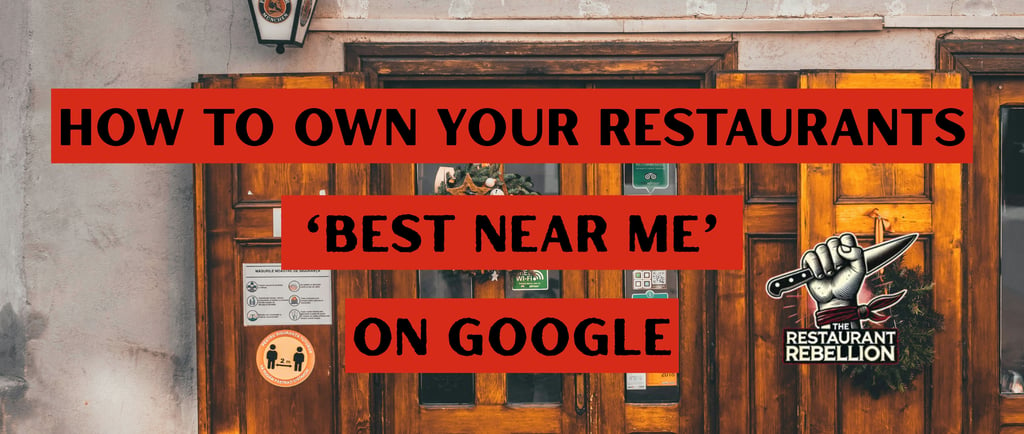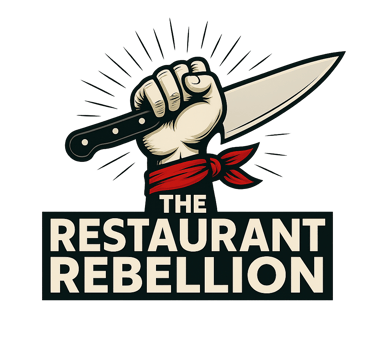Show Up, Stand Out, & Sell More: How to Rank First for "Best [Your Food Here] Near Me
Struggling to show up on Google when customers search for “best [your food] near me”? This, no-BS guide gives independent restaurant owners the exact steps to rank higher, get found fast, and turn searches into sales.
Michael Westhafer
7/11/20256 min read


Have you ever Googled "best tacos near me" and wonder why your place isn't showing up—even though you're actually the best?
Frustrating, isn’t it? You put everything into your food, your service, and creating a great vibe—but if people can’t find you when they’re hungry and searching, none of it seems to matter.
The simple fact is,: "best [cuisine] near me" is a goldmine for hungry customers, and if you're not there, you're leaving money on the table.
Think about it – when someone types that into Google on their phone, they're not casually browsing; they're ready to eat. They're looking for a quick, reliable answer to the growling in their stomachs. And that answer should be your restaurant.
The good news? You don't need some fancy SEO agency charging you a couple thousand dollars to dominate that list. This isn't about magical internet voodoo. This is about real visibility, proving your relevance, and building trust right where it counts – on the inter-webs.
You can take control of this pretty quickly, and this guide is your DIY roadmap to getting found.
How Google Ranks Local Results
You're Not Competing with the Internet. You're Competing with every restaurant on your block.
When someone searches for "best wings near me," Google isn't showing them results from across the country. It's showing them the local "map pack" results first. These are the businesses that pop up with a map, a few key details, and often a direct link to directions, call, or order online.
And their algorithm? It's laser-focused on three things to decide who gets those coveted top spots:
Relevance: Do you actually match what that hungry customer is searching for? If they search for "best sushi," Google wants to show them a sushi restaurant, not a burger joint. This means your online information (Google Business Profile) needs to clearly state what you are and what you offer.
Distance: Are you close enough to satisfy that craving right now? Google prioritizes businesses that are physically near the searcher. You can't change your location, but you can make sure Google knows exactly where you are.
Prominence: Do people trust and engage with your spot? Are you the talk of the town (online, anyway)? This is about your reputation—Your rank (stars), your reviews, and how active you are online. Google sees positive engagement as a sign of a good, reliable business.
Let's break these down in plain English, no geek-speak, so you know exactly what you're up against and, more importantly, how to beat it.
Step-by-Step: How to Rank for "Best [whatever-you-serve] Near Me"
The Local SEO Checklist for Restaurant Owners
You're busy. We get it. So, let's get to the point. Here’s your Get Er-done-checklist to start climbing the local search results:
Step 1: Claim & Fully Complete Your Google Business Profile (GBP)
This is your digital storefront, your most powerful weapon in the local search game. If you haven't claimed it, stop reading and do it now. If you have, make sure it's perfect.
Upload Sexy Food Photos: Real shots of your food, your restaurant's vibe, and your badass team. Professional photos are great, but real, customer-focused images rock too. Show people what they're missing!
Keep Your Hours Dialed In: Accurate hours, including those holiday updates, are non-negotiable. No one wants to show up to a closed door, especially when they're starving.
Write an On-Point Business Description: This is prime real estate for keywords and keyword phrases. Don't just say "We serve great food." Say "Authentic Thai food in West Midtown Atlanta – family-owned and operated since 2005." Be specific about your cuisine and your location, including the neighborhood.
Use All the Right Business Categories: Google lets you select primary and secondary categories. Be as specific as possible. If you're a "Thai Restaurant," add "Takeout Restaurant" or "Delivery Restaurant" if applicable.
Step 2: Use Real Keywords on Your Website
Your website isn't just an online billboard; it's another crucial signal to Google about what you do and where you are.
Create Hyper-Local Content: Instead of just a generic "About Us," have a page titled "Why We're Suwanee's Favorite BBQ Spot" or "The Best Pizza in Northwood." Talk about your connection to the community.
Generously Sprinkle Keywords: Include your cuisine and location keywords (and key word phrases) in your page titles, meta descriptions (the little blurb that shows up in search results), and website headlines. Make it obvious what you offer.
Ditch the Generic Copy: Replace vague phrases like "Welcome to our restaurant" with clear, search-friendly copy like "Best Mediterranean Food in Asheville" or "Authentic Mexican Cuisine in Roswell."
Embed Google Maps: Put a live, interactive Google Map on your contact or location page. This helps Google confirm your location and makes it super easy for customers to get directions.
Step 3: Get Consistent Reviews (And Respond to Them)
Reviews are powerful social proof and a huge trust signal for Google.
Ask Your Regulars: Don't be shy – ask your loyal customers to leave you 5-star reviews on Google. A simple QR code sign at the register, a link in your email signature, or even just asking nicely goes a long way.
Respond to Every Review: Good or bad, respond to every single review. Google sees this as engagement and a sign that you're an active, caring business owner. For positive reviews, say thanks. For negative ones, address the issue professionally and offer a solution.
Showcase Reviews: Don't let those great reviews just sit on Google. Pull out quotes and use them on your website and social media. Let your customers do the talking for you.
Step 4: Use Location Tags and Hashtags on Social Media
Your social media isn't just for pretty pictures; it's another signal to Google and a way to reach local customers.
Geo-tag Every Post and Story: When you post on Instagram or Facebook, always tag your location. This tells social platforms (and by extension, Google) exactly where you are.
Get Local with Hashtags: Don't just use #food. Use #bestmexicankansascity, #atlantadimsum, #denverbrunch. Think about what the locals are searching for.
Cross-Post and Link Back: Share your restaurant social content and include links back to your Google Business Profile. Drive that traffic from all directions.
Step 5: Get Listed Everywhere and Keep It Consistent
Think beyond Google. Your restaurant needs to be listed accurately across the web.
Claim Your Profiles: Yelp, TripAdvisor, Facebook, OpenTable, Apple Maps – claim your profiles on all the major restaurant and local listing sites.
Maintain NAP Consistency: Your Name, Address, and Phone number— (NAP) must match exactly across all listings. This is absolutely critical. Even a slight discrepancy (e.g., "St." vs. "Street") can confuse Google and hurt your rankings.
Common Mistakes That Keep You Invisible
Why You're Getting Beat by Chains (Even When their Food Sucks)
It's frustrating when you know your food and service is better, but the big chains with their generic menus show up first. Often, it's because of these common, easily fixed mistakes:
Your Website is All Images, No Text: Beautiful design is great, but if your website is mostly images, Google's "crawlers" can't "read" what you do. They need crawlable text.
You Uploaded a PDF Menu: Same problem. While convenient for printing, a PDF menu is hard for Google to crawl. read, and understand. Embed your menu directly on a web page as text instead.
Inconsistent Contact Info: This is a killer. If your address or phone number is different on Yelp than it is on Google, it sends mixed signals and hurts your prominence.
Not Asking for Reviews (or Ignoring Them): Silence speaks volumes. If you're not actively asking for and responding to reviews, you're missing out on vital trust signals.
Generic Headlines: "Our Story" is nice, but "Best Authentic Italian Food in Downtown Greenville" is what gets you found. Don't be afraid to use clear, search-friendly copy.
How to Know It's Working
You've put in the work, now how do you know it's paying off?
Track Your Google Search Visibility: Your Google Business Profile dashboard is a goldmine. It shows you how many people are finding you through search and maps.
Monitor Website Traffic from Search: Use Google Analytics (or your website Host dashboard) to see how much traffic is coming to your website directly from search engines.
Watch for Branded Searches: An uptick in people searching for "Carmine's Italian" (your restaurant name) instead of just "Italian near me" means you're building brand recognition.
More Directions and Phone Calls: Are you getting more requests for directions or direct phone calls from your Google listing? That's real, tangible business walking through your door (or calling your phone).
Final Thoughts: Claim Your Spot or Someone Else Will
This isn't just about getting noticed; it's about owning your positioning in the market. Being "the best" doesn't mean crap if no one can find you when they're actively searching.
These aren't complicated, mind-bending strategies. They're small, powerful tweaks that will put your restaurant squarely on the map. Stop hoping —start doing. Your next loyal customer is searching for you right now. Make sure they find you
Want help optimizing your Google profile or getting more reviews?
Send your website or Google listing to michael@restaurantrebellion.com. I'll shoot you back 3 easy wins you can implement today.
Check out Restaurantrebellion.com for more insights on digital marketing for your restaurant.


